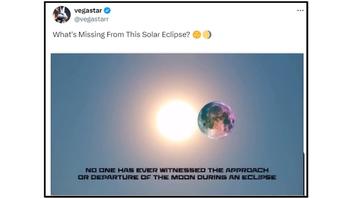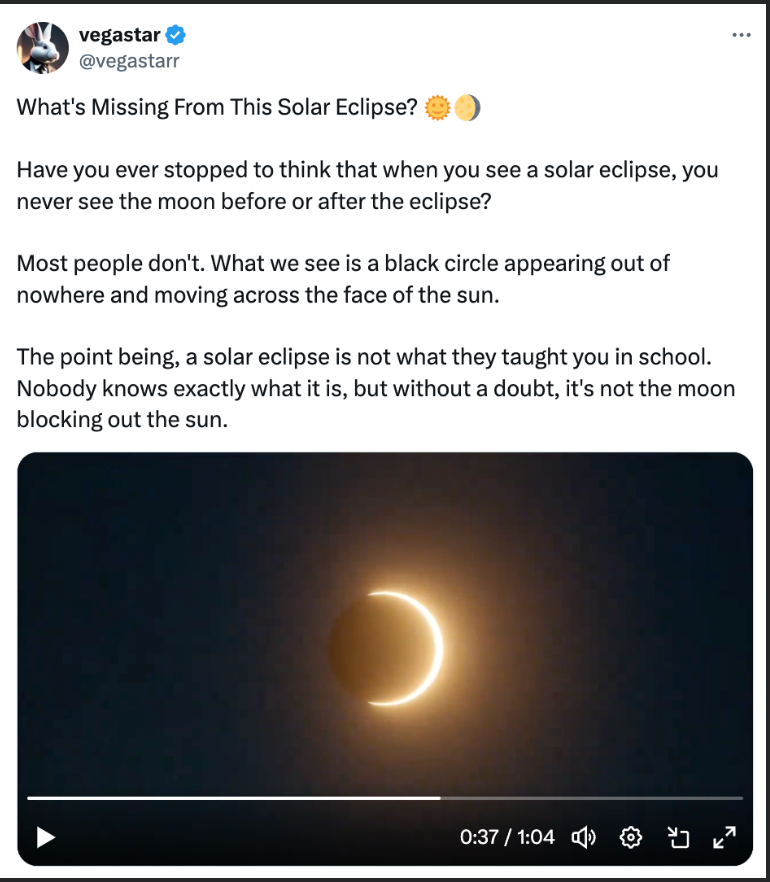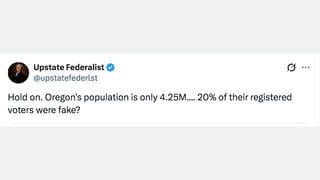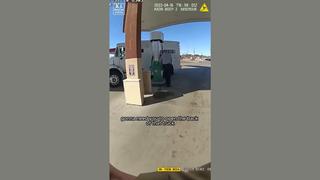
Does a solar eclipse not involve the moon blocking out the sun? No, that's not true: Experts at the National Aeronautics and Space Administration (NASA) -- an agency that has landed spacecraft on the moon -- describe a solar eclipse as that rare moment when the moon passes between the sun and Earth, blocking the face of the sun. The moon does not make its own light. It is only seen when it is reflecting sunlight, which is why it is not seen before and after the eclipse as it is between Earth and the light source of the sun.
The claim appeared in a post, where it was published on X, formerly known as Twitter, on April 8, 2024 (archived here). It opened:
What's Missing From This Solar Eclipse?
Have you ever stopped to think that when you see a solar eclipse, you never see the moon before or after the eclipse?
Most people don't. What we see is a black circle appearing out of nowhere and moving across the face of the sun.
The point being, a solar eclipse is not what they taught you in school. Nobody knows exactly what it is, but without a doubt, it's not the moon blocking out the sun.
This is what the post looked like on X at the time of writing:
(Source: X screenshot taken on Mon Apr 8 16:30:40 2024 UTC)
Lead Stories reached out to NASA for a comment on April 8, 2024, and Jennifer Dooren, deputy news chief at NASA (archived here), responded via email, sharing the NASA webpage that describes an eclipse thus: (archived here):
On April 8, 2024, a total solar eclipse will cross the continental United States, providing an exciting and breathtaking opportunity for observation and science. A total solar eclipse happens when the Moon passes between the Sun and Earth, completely blocking the face of the Sun. People located in the center of the Moon's shadow when it hits Earth will experience a total eclipse.
The sky will darken, as if it were dawn or dusk. Weather permitting, people in the path of a total solar eclipse can see the Sun's corona, or outer atmosphere, which is usually obscured by the bright face of the Sun. This total solar eclipse will be visible in 15 U.S. states, and a partial solar eclipse will be visible in all 49 continental states.
The "path of totality" of the eclipse can be seen on this NASA map (archived here).
Space.com (archived here) posted an explanation of the eclipse on the website titled, "The 5 stages of the 2024 total solar eclipse explained for April 8."
In the initial stage of the eclipse, the moon will begin to pass in front of the sun, kick-starting a partial solar eclipse. During this phase, the darkened lunar disk of the moon will make the sun appear as if a bite has been taken out of its illuminated face. This "bite" will get bigger and bigger as the totality approaches.
An explanation of why the moon will be able to cover the entire sun was also in the solar eclipse article on Space.com:
On April 8, 2024, the moon will be in its new moon phase, and it will look relatively large, meaning it is capable of covering 100% of the sun's disk as viewed from the narrow path of totality. The fraction of the diameter of the sun covered by the moon is known as the magnitude of a solar eclipse. On April 8, 2024, this value will be 1.0566, according to EclipseWise.com, slightly more than total coverage.
Stage 3 and the mid-point of the total solar eclipse is the totality. At this point, the moon completely covers the solar disk. During the totality of the outer atmosphere of the sun, the corona may become visible as white streamers at the edge of the moon. This region is usually washed out by bright light from the solar surface, the photosphere. The inner atmosphere of the sun, the chromosphere, may be visible as a wispy aura around the edge of the moon.
The totality may also make stars and planets visible in the darkened sky that are usually not visible from America during daylight hours.
NASA (archived here) explains why the moon does not have its own light:
The Moon does not make its own light --"moonlight" is actually reflected sunlight. At any moment, half of the Moon is brightly sunlit (this is the day side). The other half is in the dark (this is the night side). Throughout the month, as the Moon rotates and orbits, day and night occur on different parts of its surface, just like on Earth. Unlike our planet, though, the Moon takes a whole month to complete one rotation. This means that lunar day and night are each about two Earth weeks long.
NASA provided a livestream of the April 8, 2024, eclipse (archived here):
Other Lead Stories articles on claims regarding the April 8, 2024, eclipse are here.
















